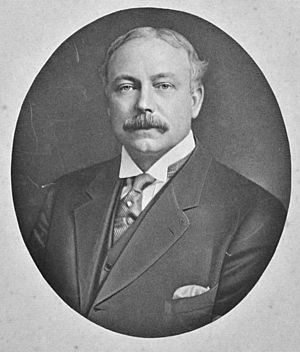Edwin Binney facts for kids
Quick facts for kids
Edwin Binney
|
|
|---|---|
 |
|
| Born | November 24, 1866 Shrub Oak, New York, U.S.
|
| Died | December 17, 1934 (aged 68) |
| Occupation | |
| Years active | 1885–1934 |
| Known for | Creator of dustless chalk Co-founder of Crayola |
Edwin Binney (November 24, 1866 – December 17, 1934) was an American inventor. He is known for creating the first dustless white chalk. He and his cousin C. Harold Smith produced the first box of Crayola crayons in 1903.
Biography
Binney was born in Shrub Oak, New York. One day while experimenting with a mixture of slate waste, cement, and talc, Binney created the first dustless white chalk. The invention was awarded a gold medal at the St. Louis World's Fair in 1904. With the help of his cousin, C. Harold Smith, Binney produced the first box of 'Crayola' crayons in 1903. It had eight colors: blue, green, red, yellow, black, brown, orange and violet. They became well-known because they were the best crayons at that time.
By 1905, the line had expanded to offering 18 different-sized crayon boxes with five different-sized crayons, only two of which survive today—the "standard size" (a standard sized Crayola crayon is 3+5⁄8 in × 5⁄16 in (92.1 mm × 7.9 mm)) and the "large size" (large sized Crayola crayons are 4 in × 7⁄16 in (102 mm × 11 mm)). The product line offered crayon boxes containing 6, 7, 8, 12, 14, 16, 18, 24, 28, or 30 different color crayons. Some of these boxes were targeted for artists and contained crayons with no wrappers, while others had a color number printed on the wrapper that corresponded to a number on a list of color names printed inside the box lid, but some boxes contained crayons with their color names printed on their wrappers.
The Rubens Crayola line, started in 1903, was directly targeted at artists and designed to compete with the Raphael brand of crayons from Europe. The crayon boxes sold from five cents for a No.6 Rubens box containing six different-colored crayons to $1.50 for the No. 500 Rubens Special Artists and Designers Crayon box containing 24 different-colored, larger (4+1⁄4 in × 1⁄2 in (108 mm × 13 mm)) crayons.
Activism
Binney was a community activist. He was responsible for Fort Pierce becoming a port city in 1921, funding a channel to be cut across Hutchinson Island. In 1929, he helped to keep the St. Lucie County Bank from succumbing to the poor economic conditions prevalent at that time. Their land holding was called Fort Pierce Farms, but wife Alice renamed it "Indrio", from Indian (for the nearby Indian River) and rio (Spanish for river).
Personal life-home
Binney was married to Alice Stead Binney (1866-1960), a London school teacher. They had four children: Dorothy Binney, Helen Binney Kitchel, Mary, and Edwin Jr. Their daughter Helen became a four-time member of the Connecticut legislature. Their daughter Mary married a tree surgeon, James A.G. Davey. Their son Edwin Jr was an international swimmer and Professor at Yale. The Binney family lived in Old Greenwich, Connecticut, as well as Fort Pierce, Florida.
Interesting facts about Edwin Binney
- Binney's wife created the portmanteau word "Crayola" by combining elements of two words: craie (French for "chalk") and ola for "oleaginou" or "oily", since the crayons were made using a petroleum based wax.
- In 1902, Binney and Smith had already invented a new wax crayon used to mark crates and barrels, but it was loaded with carbon black and too toxic for use by children. They were confident that the pigment and wax mixing techniques they had developed could be adapted to make safe wax crayons in a variety of colors.
- Binney also put forward the idea of black tires, again using carbon black, which strengthens the rubber and makes it more thermally conductive.

